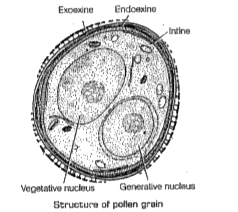Answer within 200 words : Give a structure of a typical pollen grain and its pre- and post - pollination changes .Solution in Odia
The pollen grains represent the male gametophytes of flowering plants . Microspore or pollen grains is a haploid , uninucleate and minute spore produced in large numbers by meiosis in the microspore mother cell . They vary in their size , shape , colour , design , etc. from species to species .

Pollen grains are generally spherical measuring about 25-50 micrometer in diameter. It has a two-layered wall (also called sporoderm), outer hard layer is called exine and the inner layer is intine. Exine is made up of sporopollenin. It is the most resistant organic material (fatty substance) as it can withstand high temperature and strong acids and alkali.
No known enzyme can degrade it. Thus, pollens are well-preserved as fossils. Pollen grains have prominent distal apertura for germination called germ pore, where sporopollenin is absent. The inner intine layer is thin and chiefly composed of cellulose and pectin. A pollen grain is partly germinated microspore representing the male gametophyte. Each mature pollen grain in angiosperms has two cells, the generative cell and vegetative cell.
The vegetative cell is larger, has abundant reserve food material and a large nucleus, which is irregular in shape. Whereas, the generative cell is small, spindle-shaped and floats in the cytoplasm of the vegetative cell.
Pollen grains are generally shed at this stage 2-celled in over 60% of angiosperms. In the remaining species, the generative cell divides mitotically and gives rise to two male gametes before pollen grain are shed (3-celled stage). Pollen grains have prominent distal aperture for germination celled germ pore, where sporopollenin is absent. Pollen grains are rich in nutrients.
Topper's Solved these Questions
- SEXUAL REPRODUCTION IN FLOWERING PLANT BOOK - ARIHANT PRAKASHANCHAPTER - SEXUAL REPRODUCTION IN FLOWERING PLANT EXERCISE - TOPIC -1 - TOPIC TEST 1
10 Videos
- SEXUAL REPRODUCTION IN FLOWERING PLANT BOOK - ARIHANT PRAKASHANCHAPTER - SEXUAL REPRODUCTION IN FLOWERING PLANT EXERCISE - TOPIC -2- PRACTICE QUESTION EXAMS. TEXTBOOK.S & OTHER IMP. QUESTIONS (1 MARK QUESTIONS IMPORTANT QUESTIONS )
17 Videos
- SEXUAL REPRODUCTION IN FLOWERING PLANT BOOK - ARIHANT PRAKASHANCHAPTER - SEXUAL REPRODUCTION IN FLOWERING PLANT EXERCISE - TOPIC -1 -PRACTICE QUESTIONS Exams. , Textbook.s & Other Imp. Questions (3 1/2 MARK Questions Exam Questions)
4 Videos
- SEX-DETERMINATION BOOK - ARIHANT PRAKASHANCHAPTER - SEX-DETERMINATION EXERCISE - CHAPTER TEST (7 MARK QUESTION)
2 Videos
- VERY SIMILAR TEST 3 BOOK - ARIHANT PRAKASHANCHAPTER - VERY SIMILAR TEST 3 EXERCISE - Section B (Zoology) Group C
9 Videos
Similar Questions
……….. , is the cushion of parerichymatous cell that joins ovary and ovule .
View SolutionDue to triple fusion , ________________ is formed .
View SolutionDifferentiate between apospory and apogamy.
View SolutionDifferentiate between XX chromosomes and XY chromosomes
View SolutionSecondary sexual characters
View SolutionPollination occurs when a pollen grain
View SolutionIn Cycas, at the time of pollination, the pollen grains is/are
View SolutionPollen grains insect pollinated flowers are
View Solutionimagine the structure of pollen grain of a sweet scented small flower and the structure of ovule . From the appearance of the pollen grain . (a) Identify the agent of pollination . (b) During fertilization what will be the contribution of the pollen grain in the female gametophyte ?
View SolutionDraw and label the structure of a typical pollen grain.
View SolutionGive the structure of pollen grain.
View SolutionPollination occurs when a pollen grain
View SolutionGive a structure of a typical pollen grain and it's pre- and post-pollination changes.
View SolutionAnswer within 200 words : Give a structure of a typical pollen grain and its pre- and post - pollination changes .
View SolutionAfter Pollination,if the 2-celled pollen grain comes across dry stigma, then there will not be germination of pollen grain. Give reason.
View Solution
